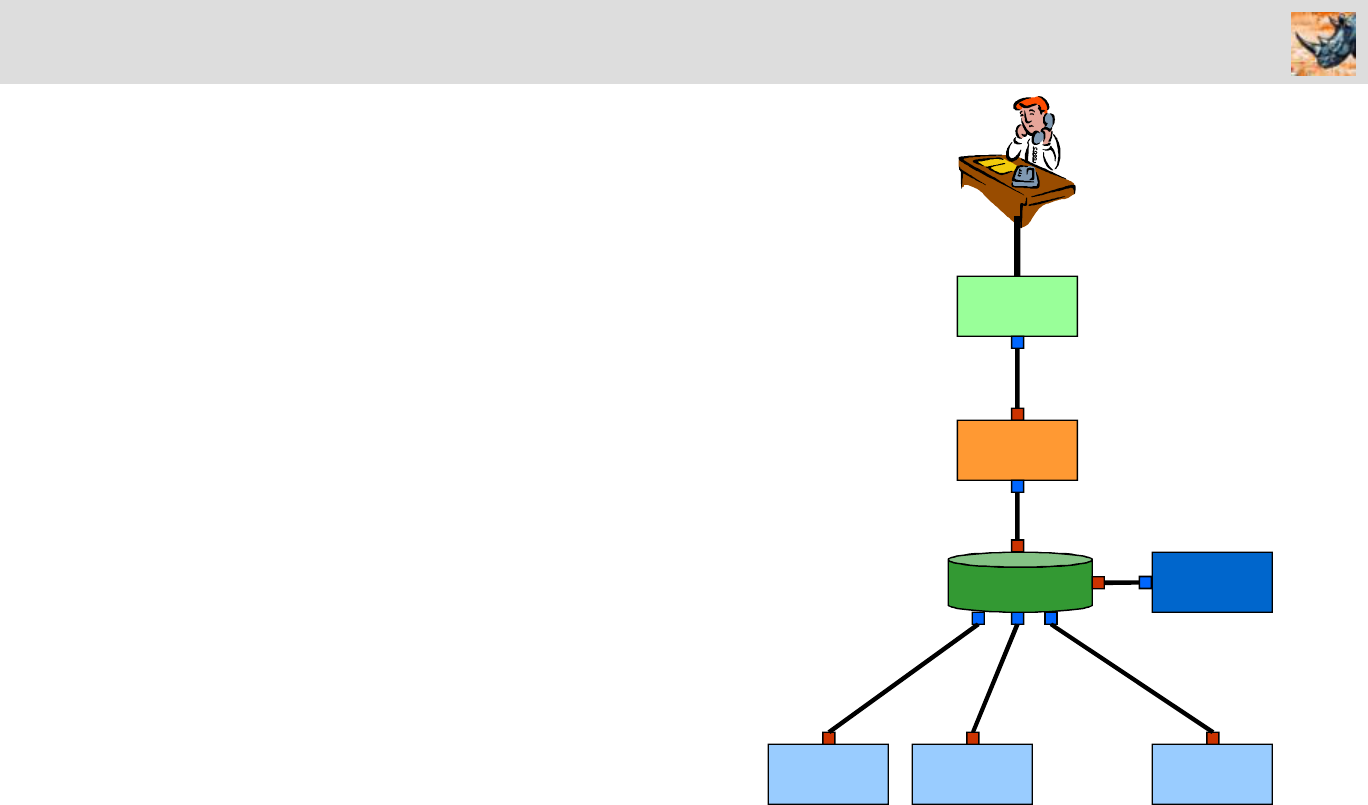
Introduction to Software Architecture
George Fairbanks
18 September 2012
Rhino Research
Software Architecture Consulting and Training

Copyright 2007-2012 George Fairbanks, Rhino Research
A tale of two systems
Plain Old Telephone System
• Feature:
§ Call subscriber
• Architecture:
§ Centralized hardware switch
• Good qualities
§ Works during power outages
§ Reliable
§ Emergency calls get location
information
Skype
• Feature:
§ Call subscriber
• Architecture:
§ Peer-to-peer software
• Good qualities
§ Scales without central
hardware changes
§ Easy to add new features
(e.g., video calling)
2
Architects pay more attention to qualities
that arise from architecture choices.
Same featureSame feature

Copyright 2007-2012 George Fairbanks, Rhino Research
Let’s design a system!
• Here’s the situation
§ You are a hosting provider
§ You rent mail servers
§ Customers have problems
§ You use the mail log files to
diagnose their problems
• The big question:
§ How would you build it?
• Let’s assume you can build it
§ … but different architectures
yield different qualities
• Why is this hard?
§ You have hundreds of servers
§ You generate GBs of logs daily
§ Collecting logs takes time
§ Searching logs takes time
• Hints and options
§ Central collection of logs?
§ Distributed searching of logs?
§ Can you pre-process logs to
speed up queries?
3

Copyright 2007-2012 George Fairbanks, Rhino Research
Surprise! The system is real: Rackspace
• Exercise based on real experience
§ Rackspace is a hosting provider
§ Huge growth in customers, mail servers –and problems
§ Re-designs: 3 major versions (6 total versions)
• Let’s review the 3 systems they built
§ All 3 had the same functionality (!)
§ … but different architectures
• Why this is so cool
§ Very expensive to build the same system 3 times
§ The only big change was the architecture
§ So, we can see the effect of architecture
§ … especially on quality attributes
4
Source: http://highscalability.com/how-rackspace-now-uses-mapreduce-and-hadoop-query-terabytes-data

Copyright 2007-2012 George Fairbanks, Rhino Research
5
Rackspace: Architecture 1
• Hosting provider of email service
• Email log files
• Task: debug user problem
• Architecture
§ CSR desktop computer
§ ssh connections to servers
§ Servers with local log files
• Procedure
§ Write query as grep expression
§ Script runs via ssh on every server
§ Results aggregated
…
CSR desktop
ssh
Log
data
Email
Servers
CSR

Copyright 2007-2012 George Fairbanks, Rhino Research
6
Rackspace: Architecture 2
• Hosting provider of email service
• Email log files
• Task: debug user problem
• Architecture
§ CSR desktop computer
§ Web application
§ MySQL database
§ scp log transfer
§ Servers with local log files
• Procedure
§ Every 10 minutes, send log files to
MySQL server; delete original
§ Parse and load logs into MySQL
§ Combine new logs with old
§ Send query to MySQL server;
answered from DB data
…
CSR
CSR desktop
scp
Email
Servers
Log
data
MySQL
Web / http
Web app
SQL
DB

Copyright 2007-2012 George Fairbanks, Rhino Research
7
Rackspace: Architecture 3
• Hosting provider of email service
• Email log files
• Task: debug user problem
• Architecture
§ CSR desktop computer
§ Web application
§ Distributed filesystem
§ Map-Reduce job cluster
§ Servers with local log files
• Procedure
§ Log data continuously streamed
from email servers to distributed
filesystem (HDFS)
§ Every 10 minutes, Map-Reduce job
runs to process log files, create
index
§ Web app queries index
…
CSR
CSR desktop
scp
Email
Servers
Map-
Reduce
Job
Web / http
Web app
Distributed
Filesystem

Copyright 2007-2012 George Fairbanks, Rhino Research
8
Rackspace: Quality attribute tradeoffs
• Tradeoff: Data freshness
§ V1: Queries run on current data
§ V2: Queries run on 10 minute old data
§ V3: Queries run on 10-20 minute old data
• Tradeoff: Scalability
§ V1: Noticeable email server slowdown (dozens of servers)
§ V2: MySQL speed/stability problems (hundreds of servers)
§ V3: No problems yet
• Tradeoff: Ad hoc query ease
§ V1: Regular expression
§ V2: SQL expression
§ V3: Map-Reduce program

Copyright 2007-2012 George Fairbanks, Rhino Research
9
What is software architecture?
• In loose language:
§ It’s the “big picture” or “macroscopic” organization of the system
• Problem with these definitions
§ Why are some detailed designs architectural, others not?
§ Architecture includes whatever architects say it does
The software architecture of a computing system is the set of structures
needed to reason about the system, which comprise software elements,
relations among them, and properties of both. [Documenting Software
Architectures (SEI) 2010]
Architecture is defined by the recommended practice as the fundamental
organization of a system, embodied in its components, their relationships to
each other and the environment, and the principles governing its design and
evolution. [IEEE 2000]

Copyright 2007-2012 George Fairbanks, Rhino Research
10
All programs have an architecture
• Every program has an architecture
• … but not every architecture suits the program
• System requirements
§ Functional needs
§ Quality needs (e.g., performance, security)
• Alignment*
§ Different architectures support different requirements
§ E.g., supporting high throughput vs. interactivity
§ Right: Suitable vs. unsuitable
• Wrong: Good vs. bad
• Hard to change architecture later
§ Does not mean BDUF
§ But, need to think “enough”
* Generally, this word is overused by consultants

Copyright 2007-2012 George Fairbanks, Rhino Research
What if you don’t think architecturally?
• Developers optimize locally, miss the big picture
§ Lousy choice of frameworks, languages, …
• Project success depends on having virtuosos in the team
§ But how many James Goslings and Jeff Deans are there?
• Poor communication
§ Idiosyncratic notations, fuzzy semantics
• Shallow (or no) analysis of design options
§ Ad hoc; no use of best practices
§ From first principles, therefore high effort
§ Little attention to tradeoffs and rationale
• Architectural patterns ignored
§ … or incorrectly chosen
§ Squandering known-good designs
11

Copyright 2007-2012 George Fairbanks, Rhino Research
Virtuosos and Roman engineers
• Life is unfair
§ Mozart was a virtuoso composer
§ Some of you are virtuoso software designers
• Today, every civil engineer is better than Roman engineers
§ Virtuosos invent cement –the rest of us can use it
§ And you are a 99
th
percentile mathematician –for the 17
th
century
§ We can teach engineering and math
• Can we teach software architecture?
§ Yep, we’re getting pretty good at it
§ Sorry, we can’t make you Mozart
12

Copyright 2007-2012 George Fairbanks, Rhino Research
Overview
• Architecture, architecting, architects
• Views
• Quality attributes
• Analysis
• Standard notations
• Guiderails
• Architectural styles
• Conceptual model
• Engineering with models
• Canonical model structure
• Models and code
• Process and risk
13
Design
Domain
model
Boundary
model
designation
Internals
model
refinement
Code
model
designation
View
Master model
Real-world problem Real-world solution
Model
problem
Model
solution
solve
solve
abstract
concretize

Copyright 2007-2012 George Fairbanks, Rhino Research
Architecture vs. architecting vs. architect
• Must keep these ideas separate:
§ The job title/role “architect”
§ The process of architecting/designing (also: when)
§ The engineering artifact called the architecture
• Course focus: architecture (the engineering artifact)
• Every system has an architecture
§ Identify it by looking back (avoids tangling with process & roles)
§ E.g., “Aha, I see it is a 3-tier architecture”
• Help disentangling
§ Car architectures
§ Rackspace architectures
14
See: Just Enough Software Architecture, Ch 1 Sec 5

Copyright 2007-2012 George Fairbanks, Rhino Research
15
Views

Copyright 2007-2012 George Fairbanks, Rhino Research
16
Views
• Definition
§ A view is a projection of a model
showing a subset of its details
§ A view is a relationship between
two models
• Views: the modeling workhorse
• Projections from master model
§ Master model has all details
• I.e., THE design
§ Views are projections of the
master model
• Subsets of its information
• Master model may not concretely
exist
§ E.g., build top-down 2D view of
house, imagine 3D model
§ Imagine 3D house modeling
software
• Can project any cross-section
(view)
• Ignore concrete representation of
3D model (arbitrary choice)
View
Master model
Has all
details
Subset of
details
See: Just Enough Software Architecture, Ch 13

Copyright 2007-2012 George Fairbanks, Rhino Research
17
Multiple views
• Example house views:
§ 2D view of floor plan
§ Electric wiring circuits
§ CAT5 wiring and routing
§ HVAC distribution
§ Plumbing
§ Landscaping
§ Inventory of windows
§ Taxation
§ Zoning
2D Floor plan View
Windows:
§ 3 in front
§ 4 in back
Window View
…
HVAC View
…
Electric View
Master model
See: Just Enough Software Architecture, Ch 13

Copyright 2007-2012 George Fairbanks, Rhino Research
18
Architectural viewtypes
• Definition:
§ A viewtype is a category of views that are easy to reconcile with
each other.
• E.g., physical, political views of a house
• Reconciling views in a viewtype
§ Easy within viewtype
• E.g., electrical and floorplan = easy
§ Hard between viewtypes
• E.g., taxation and roofing = hard
• Standard architectural viewtypes
§ Module viewtype
• Source code, config files, module dependencies
§ Runtime viewtype (aka component and connector, C&C viewtype)
• Components, connectors, ports
§ Allocation viewtype
• Servers, geography
See: Just Enough Software Architecture, Ch 13

Copyright 2007-2012 George Fairbanks, Rhino Research
19
Quality Attributes

Copyright 2007-2012 George Fairbanks, Rhino Research
20
Quality attributes (QA’s)
• Definition: A quality attribute is a dimension of quality used to
evaluate a software system.
§ E.g., performance, scalability, modularity, usability, security
§ A.k.a., non-functional qualities, extra-functional qualities, the “ities”
• Generally, any architecture can achieve any feature
§ BUT: qualities will suffer or be harder to achieve
• Why study QA’s?
§ Significant failure risks from QA’s
§ Intersection of business & technology
• Software architecture & QA’s
§ Architecture decides range of QA possibilities
§ Architectures evaluated w.r.t. QA’s
See: Just Enough Software Architecture, Ch 12 Sec 10

Copyright 2007-2012 George Fairbanks, Rhino Research
21
QA's as independent dimensions
• Optimizing one QA
§ Architecture, design changes to maximize a QA
§ Generally, 1 QA is easy
• Optimizing across many QA’s
§ Cannot maximize all QA’s at once
§ Tradeoffs
• E.g., most usable UI might be less secure
• E.g., highest throughput is batch mode UI
§ “Design space” –choosing is hard
• Consequence: Must prioritize QA’s
throughput
security
usability
Your system will
live at a point in the
Design Space

Copyright 2007-2012 George Fairbanks, Rhino Research
22
Analysis

Copyright 2007-2012 George Fairbanks, Rhino Research
Trade-offs
• Tradeoff: More of this à less of that
• Examples
§ Portability vs. playback efficiency. Platform-specific resources
(e.g., dedicated hardware) often provide media playback benefits,
including efficiency, yet using these resources ties the software to
that platform
§ Weight vs. speed. The heavier a car is, the slower it accelerates.
• Everything trades off against cost
23
See: Just Enough Software Architecture, Ch 12 Sec 13

Copyright 2007-2012 George Fairbanks, Rhino Research
Architecture drivers
Architecture drivers
• Template: stimulus and response
§ Stimulus: agent or situation that
triggers scenario
§ Response: reaction to stimulus
• Each QA scenario can be graded
by:
§ Importance to stakeholder
(high, medium, low)
§ Difficulty to implement
(high, medium, low)
• Architecture drivers are
§ QA scenarios
§ or functional scenarios (eg use
cases)
§ that are rated (H,H)
Examples
• S1 (H,H):
§ When a librarian scans a book
copy for checkout, the system
updates its records and is ready to
scan the next one within 0.25
seconds.
• S2 (M,H):
§ When librarian station cannot
contact the main system,
librarians can continue to check
books in and out.
24
QA scenarios and drivers from Bass et al., Software Architecture in Practice, 2003
See: Just Enough Software Architecture, Ch 12 Sec 11

Copyright 2007-2012 George Fairbanks, Rhino Research
Rational architecture decisions
• Design rationales explain why
• They should align with your quality attribute priorities
<x> is a priority, so we chose design <y>, accepting downside <z>.
• An example:
§ Since avoiding vendor lock-in is a high priority, we choose to use a standard
industry framework with multiple vendor implementations, even though using
vendor-specific extensions would give us greater performance.
• But: Good intentions can go awry
§ E.g., performance optimization hindering modifiability
25
See: Just Enough Software Architecture, Ch 5 Sec 4

Copyright 2007-2012 George Fairbanks, Rhino Research
26
Analyzing views
• Views make analysis easier
§ Choice of view essential
• Some views have custom visualizations
§ Usually improve analysis or comprehension
• Which view makes the question easy?
§ What is shortest path?
§ Estimated temperature?
§ Impact of short in bathroom?
§ Good afternoon reading light?
§ Tax burden of new wing?
2D Floor plan View
…
HVAC View
…
Electric View
See: Just Enough Software Architecture, Ch 15

Copyright 2007-2012 George Fairbanks, Rhino Research
27
Standard Notations

Copyright 2007-2012 George Fairbanks, Rhino Research
Standard notation (UML)
• “By relieving the brain of all unnecessary work, a good notation sets it
free to concentrate on more advanced problems, and in effect
increases the mental power of the race.”
–Alfred Whitehead, 1911
• Clear, consistent notation
§ Aids communication
§ Aids analysis
• UML
§ Not perfect for architecture
§ One size fits all
28
From UML 2.1.2 specification

Copyright 2007-2012 George Fairbanks, Rhino Research
29
Guiderails

Copyright 2007-2012 George Fairbanks, Rhino Research
Guiderails (constraints)
• Developers voluntarily constrain systems
§ Counter-intuitive
§ Ensures what a system does not do
§ I.e., guiderails
• Constraints help ensure outcomes
§ E.g., ensure quality attributes are met
§ No constraints = no analysis
• Examples of architectures à QA’s
§ Plugins must use cross-platform API to read files à portability
§ EJBeans must not start own threads à manageability
§ EJBeans must not write local files à distribution
30
See: Just Enough Software Architecture, Ch 16 Sec 4

Copyright 2007-2012 George Fairbanks, Rhino Research
31
Architectural Styles

Copyright 2007-2012 George Fairbanks, Rhino Research
Architectural styles
• Examples
§ Big ball of mud
§ Client-server
§ Pipe-and-filter
§ Map-reduce
§ N-tier
§ Layered
§ …
• Each predefines
§ Elements (e.g., pipes, map functions)
§ Constraints, …
• Benefits
§ Known tradeoffs
§ Known suitability
§ Compact terminology for communication
32
See: Just Enough Software Architecture, Ch 14

Copyright 2007-2012 George Fairbanks, Rhino Research
33
Conceptual Model

Copyright 2007-2012 George Fairbanks, Rhino Research
What is a conceptual model?
• What is a conceptual model?
§ A conceptual model is a set of concepts that can be imposed on raw
events to provide meaning and structure.
• It organizes chaos
§ Enables intellectual understanding
§ Fits big problems into our finite minds
• Synonyms:
§ Conceptual framework
§ Mental model
34
See: Just Enough Software Architecture, Ch 7

Copyright 2007-2012 George Fairbanks, Rhino Research
35
Examples of conceptual models
Physics: Free Bodies
Econ: Supply & demandEnergy cycle
Accounting: Debits & credits
Sports: Plays, strategies,
assignments

Copyright 2007-2012 George Fairbanks, Rhino Research
36
Conceptual model of software architecture
• Model relationships
§ Views & viewtypes
§ Designation
§ Refinement
• Canonical model structure
§ Domain model
§ Design model
• Internals model
• Boundary model
§ Code model
• Quality attributes
• Design decisions
• Tradeoffs
• Responsibilities
• Constraints (guide rails)
• Viewtypes
§ Module
§ Runtime
§ Allocation
• Module viewtype
§ Modules
§ Dependencies
§ Nesting
• Runtime viewtype
§ Components
§ Connectors
§ Ports
• Allocation viewtype
§ Environmental element
§ Communication channels
See: Just Enough Software Architecture, Ch 7

Copyright 2007-2012 George Fairbanks, Rhino Research
37
Engineering with Models

Copyright 2007-2012 George Fairbanks, Rhino Research
Why use models?
• We battle complexity and scale with models
§ Models fit in our heads
§ Models help us analyze the problem
• So, what kinds of (meta) models?
§ Enterprise Architecture: many competing (meta) models
§ Application Architecture: general consensus
• Use != Build
§ How much you write down is a choice
§ But you need a (meta) model
38
See: Just Enough Software Architecture, Ch 6

Copyright 2007-2012 George Fairbanks, Rhino Research
Commuting diagram
Mary Shaw's commuting diagram:
Real-world problem Real-world solution
Model
problem
Model
solution
“A train is traveling south at 10m/s. Another
departs 30 minutes later at 15m/s. When do
they meet?”
solve
solve
abstract
concretize
39
See: Just Enough Software Architecture, Ch 6

Copyright 2007-2012 George Fairbanks, Rhino Research
40
Canonical model structure

Copyright 2007-2012 George Fairbanks, Rhino Research
41
Canonical model structure (1)
• A domain model expresses the intentions,
concepts, and workings of the domain.
§ Omits references to the system to be built
§ Is a bridge between engineers and domain experts
• A boundary model expresses the capabilities of
the system.
§ Centerpiece is the system to be built
§ Focus on system capabilities, not design
§ There is a single top-level boundary model
• An internals model expresses the design of the
system.
§ Refines a boundary model
§ Describes assembly of components that conform to
boundary specification
• A code model expresses the solution, either as
source code or an equivalent diagram
§ Some design intent lost in code model
Design
Domain
model
Boundary
model
designation
Internals
model
refinement
Code
model
designation
Q: What does a box labeled “customer” represent in each of these models?
See: Just Enough Software Architecture, Ch 7 Sec 1

Copyright 2007-2012 George Fairbanks, Rhino Research
42
Canonical model structure (2)
• The “canonical stack” of models
§ May not build all on every project
• Each folder
§ Contains models (documents)
§ A single level of abstraction (detail)
• Artifacts != sequence
§ Our models are related via refinement
§ We rarely build top-down
• Design model
§ Boundary + Internals
§ Nest recursively
Design
Domain
model
Boundary
model
designation
Internals
model
refinement
Code
model
designation
Each component in
an internals model is
itself a boundary
model
Can continue
refining, show
more details

Copyright 2007-2012 George Fairbanks, Rhino Research
43
Models and Code

Copyright 2007-2012 George Fairbanks, Rhino Research
44
Architecture vs code –different things easy to see
• When reading code, want to know:
§ Who talks to who
§ Invariants and constraints
§ Messages sent and received
§ Styles and patterns
§ Performance requirements or guarantees
§ Data structures used for communication
§ Etc.
• Easy to see in architecture model, hard to see in code
• Why?
§ A single object rarely has a big impact on QA’s
§ Cannot infer design from code
• e.g., “never call A from B”, “always do X before Y”
• Yet
§ Code-level decisions “bubble up” into QA’s
§ Architecture decisions directly influence QA’s
See: Just Enough Software Architecture, Ch 10

Copyright 2007-2012 George Fairbanks, Rhino Research
45
Architecturally evident coding style
• Current practice
§ Provide hints useful to humans
§ Use “totalExpenses” instead of just “t” variable
§ Intention revealing method names
• Idea: Express architectural ideas
§ Provide hints about architecture
§ Do more than is necessary for program to compile
§ Preserve design intent
• Benefits
§ Avoid future code evolution problems
§ Improve developer efficiency
• Reduce time spent inferring from code
§ Lower documentation burden
§ Improve new developer ramp-up
See: Just Enough Software Architecture, Ch 10 Sec 3

Copyright 2007-2012 George Fairbanks, Rhino Research
46
Process & Risk

Copyright 2007-2012 George Fairbanks, Rhino Research
47
Engineering failures
Required
• Considering failures
• Analyzing options
• Designing a solution
You can choose
• When design happens
• Which analyses
• Formality / precision
• Depth
The concept of failure is central to the design process, and it is by
thinking in terms of obviating failure that successful designs are
achieved. ... Although often an implicit and tacit part of the
methodology of design, failure considerations and proactive failure
analysis are essential for achieving success. And it is precisely when
such considerations and analyses are incorrect or incomplete that
design errors are introduced and actual failures occur.
[Henry Petroski, Design Paradigms, 1994]
See: Just Enough Software Architecture, Ch 3

Copyright 2007-2012 George Fairbanks, Rhino Research
Inspiration: Dad vs. mailbox
• My Dad
§ Mechanical engineer
§ Capable of analyzing stresses and strains
• The problem
§ Install new mailbox
• His solution
§ Dig hole
§ Stick in post
§ Fill with concrete
• Q: Why no mechanical engineering
analyses?
• A: Risk
§ He just wasn’t worried enough
48
See: Just Enough Software Architecture, Ch 3

Copyright 2007-2012 George Fairbanks, Rhino Research
Insight #1: Decide effort using risks
• At any given moment, you have worries and non-worries
§ Worry: Will the server scale up?
§ Worry: Will bad guys steal customer data?
§ Response time will be easy to achieve
§ We have plenty of RAM
• Cast these worries as engineering risks
§ Focus on highest priority risks
• Good news: prioritizing risks is easy for developers
§ They can tell you what they are most worried about
§ I.e., possible failures
49
See: Just Enough Software Architecture, Ch 3 Sec 1

Copyright 2007-2012 George Fairbanks, Rhino Research
Insight #2: Techniques mitigate risks
• Many architecture techniques exist
§ Protocol analysis
§ Component and connector modeling
§ Queuing theory
§ Schedulability analysis
§ Threat modeling
§ …
• Techniques are not interchangeable
§ E.g., cannot use threat modeling on latency risks
• So, must match risks with techniques
§ I.e., mapping from risks à techniques
§ Inspired by Attribute Driven Design (ADD)
50
See: Just Enough Software Architecture, Ch 3 Sec 4

Copyright 2007-2012 George Fairbanks, Rhino Research
Risk-Driven Model
• The Risk-Driven Model:
1. Identify and prioritize risks
2. Apply relevant architecture activities
3. Re-evaluate
• Must balance
§ Wasting time on low-impact techniques
§ Ignoring project-threatening risks
Ron ArmsCtrong, CC
51
See: Just Enough Software Architecture, Ch 3 Sec 1

Copyright 2007-2012 George Fairbanks, Rhino Research
Process, risk, and Rackspace example
• Agile/lean architecture
§ Agile processes: few design techniques
§ Architecture: many design techniques
§ Use the risk-driven model to combine
• Rackspace: Did they proceed rationally?
§ Should they have done Big Design Up Front (BDUF)?
§ Should they have evolved the architecture?
§ What risks did they face?
52
Version 1 Version 2 Version 3
…
CSR desktop
ssh
Log
data
Email
Servers
CSR
…
CSR
CSR desktop
scp
Email
Servers
Log
data
MySQL
Web / http
Web app
SQL
DB
…
CSR
CSR desktop
scp
Email
Servers
Map-
Reduce
Job
Web / http
Web app
Distributed
Filesystem

Copyright 2007-2012 George Fairbanks, Rhino Research
Summary
• Architecture, architecting, architects
• Views
• Quality attributes
• Analysis
• Standard notations
• Guiderails
• Architectural styles
• Conceptual model
• Engineering with models
• Canonical model structure
• Models and code
• Process and risk
53
Design
Domain
model
Boundary
model
designation
Internals
model
refinement
Code
model
designation
View
Master model
Real-world problem Real-world solution
Model
problem
Model
solution
solve
solve
abstract
concretize
